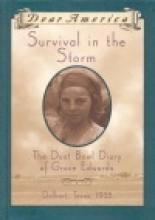No name
Pegeen
Subject(s):
Setting:
Grade / Age level:
Review:
Pegeen is the final book in the Bantry Bay Series, which chronicles the O'Sullivan family of Ireland in the 1930s. In this story, Pegeen, an orphan who was befriended by Francie in the previous story, comes to live with the O'Sullivans while waiting to be sent to her uncle in America. A rather wild girl with very little "upbringing", Pegeen gets into all kinds of trouble and adventures. In the midst of all this she manages to win the hearts of the O'Sullivans and does learn to become more responsible for her actions. The conclusion is very sweet and touching. Pegeen will surely capture your heart too!
Perspective:
Catholic
Reviewed by:
First reviewed:
12-17-99
Survival in the Storm
The Dust Bowl Diary of Grace Edwards
Subject(s):
Setting:
Grade / Age level:
Review:
My ten year old daughter has been enjoying the Dear America series from Scholastic. I believe that they've had a positive effect on her character (particular in the "complaint" department) as the stories focus on girls about her age living in difficult times. As they're written by a number of different authors, please don't take this review as an endorsement of all of the titles.
Survival in the Storm is the fictional story (in the format of a diary) of twelve-year old Grace Edwards who lives in Dalhart, Texas - a city near the center of the five-state area hardest hit by the infamous droughts and dust storms that plagued the Southwest for nearly a decade during the Great Depression.
The story provides a nice balance of family stability amidst hardships that give children today a fair look at the challenges of life in that time period. Grace volunteers at a hospital alongside her mother where the reader learns of the terrible illnesses associated with the dust storms. Families band together to help each other when hard times come and many leave for the "promised land" of California, only to be stuck in migrant camps where conditions are no better than at home. Throughout the story, virtues of perseverance and kindness are shown to be the things that "get people through" tough times.
Survival in the Storm is the fictional story (in the format of a diary) of twelve-year old Grace Edwards who lives in Dalhart, Texas - a city near the center of the five-state area hardest hit by the infamous droughts and dust storms that plagued the Southwest for nearly a decade during the Great Depression.
The story provides a nice balance of family stability amidst hardships that give children today a fair look at the challenges of life in that time period. Grace volunteers at a hospital alongside her mother where the reader learns of the terrible illnesses associated with the dust storms. Families band together to help each other when hard times come and many leave for the "promised land" of California, only to be stuck in migrant camps where conditions are no better than at home. Throughout the story, virtues of perseverance and kindness are shown to be the things that "get people through" tough times.
Reviewed by:
First reviewed:
10-13-03
Voyage on the Great Titanic
The Diary of Margaret Ann Brown
Subject(s):
Setting:
Review:
A fictional diary of a young Irish-English girl who is raised in a Catholic orphanage in London and is hired as a companion to a wealthy lady for the duration of the Titanic's voyage to America (where she hopes to meet up with her older brother). Margaret, having lived on the streets with her brother for some time before coming to the orphanage, is wise beyond her years with a somewhat cynical streak. Her attitude toward the opulence of the Titanic and the lifestyle of her first class passengers gives the reader both a sense of the historical reality of the Titanic and the times in which this tragic event took place. It is within this context that mankind learned a severe lesson about his own limitations. I think it is a rather good way to illustrate these details of the Titanic - through the eyes of someone who, like us, is unaccustomed to such things.
The author attempts to treat the Catholic Church and Margaret's Irish-Catholic upbringing with respect. However, she betrays a lack of understanding of at least one rather significant detail... In the story, Margaret makes no distinction between a Catholic Mass and a "Mass" [according to the story] which is presided over by the ship's captain. In reality a girl who had spent five years in an orphanage (and become close friends with the nuns there) would have been familiar with these distinctions and considered them important. We also know that there was a Catholic Mass said aboard the Titanic that fateful Sunday (as explained on the website about Fr. Thomas Byles).
Margaret has a rather innocent romantic interest in one of the ship's stewards (although I imagine that the two of them spending time alone together would probably have been frowned upon) and receives a farewell kiss from him before he goes down with the Titanic.
It might make an interesting point of discussion to consider how Margaret (or someone in her position) might have turned to her Catholic faith in order to try to cope with her loss in this great tragedy.
The author attempts to treat the Catholic Church and Margaret's Irish-Catholic upbringing with respect. However, she betrays a lack of understanding of at least one rather significant detail... In the story, Margaret makes no distinction between a Catholic Mass and a "Mass" [according to the story] which is presided over by the ship's captain. In reality a girl who had spent five years in an orphanage (and become close friends with the nuns there) would have been familiar with these distinctions and considered them important. We also know that there was a Catholic Mass said aboard the Titanic that fateful Sunday (as explained on the website about Fr. Thomas Byles).
Margaret has a rather innocent romantic interest in one of the ship's stewards (although I imagine that the two of them spending time alone together would probably have been frowned upon) and receives a farewell kiss from him before he goes down with the Titanic.
It might make an interesting point of discussion to consider how Margaret (or someone in her position) might have turned to her Catholic faith in order to try to cope with her loss in this great tragedy.
Reviewed by:
First reviewed:
7-7-2000
Introduction to Catholicism
Subject(s):
Grade / Age level:
Resource Type:
Review:
Perspective:
Catholic
Reviewed by:
First reviewed:
2-28-07
A Story of Saint Elizabeth of Hungary
Grade / Age level:
Review:
In this charming, simple story, we are introduced to St. Elizabeth, beginning with her birth and covering her complete life. Clearly, the style is written for younger children. "She was born in a big castle in Hungary way back in 1207--a long, long time ago!" Although the story is written for younger children, the language and storyline are not watered down, touching on the important events in her life as well as addressing the problems she encountered. "Soon some of the members of the court began to spread rumors against the princess." Throughout the story, vignettes of her sanctity are revealed in both the dialogue and the narrative. "When they got to the church door, Elizabeth stopped and took off her crown. 'I cannot wear a crown of gold and jewels when Jesus, my King, wears a crown of thorns!'"
St. Elizabeth presents a realistic portrait of a saint, who sought to follow God's will for her vocation in a balanced way. "These children required much of Elizabeth's time, but no matter what else there was to be done, they came first."
Even though it is written for young children, the story is engaging for all ages: no sugar coating of the realities she underwent, yet holds the attention of the reader until the end. Originally, there were several hundred Dujarie books, hopefully many more will be reprinted.
The popular Dujarie saint series from the 40s, 50s and 60s is back in print. There are two recommended reading levels: 1st level, 2nd gr. and up; 2nd level, 4th gr. and up. Saint Elizabeth is the first reading level. Some of the vocabulary is not typical for 2nd grade, e.g."expression of veneration." Since most 2nd graders are not proficient at reading, some will prefer to have the book read aloud.
Perspective:
Catholic
Additional notes:
Available from www.marys-books.com
First reviewed:
5-14-2010
Saint Clare of Assisi
A Light for the World
Grade / Age level:
Review:
With warm, cute illustrations, and accessible language, the courageous story of Saint Clare comes alive in this little book! Young readers will be captivated by the story of a girl who gave up everything for the love of God! Her many miracles, her life in poverty, the love she had for Saint Francis and her sisters: it is all in there.
A final chapter explains how the order grew and subsequent decisions made about it-- for instance the changing of its name to the Order of Saint Clare in 1263. There are also a beautiful prayer and a glossary for terms that may be unfamiliar to young readers.
Reviewed by:
First reviewed:
8-2-2010
Schoolhouse in the Woods
Subject(s):
Grade / Age level:
Review:
This second installment in the Fairchild Family Series (which starts with The Happy Little Family) is a charming account of young Bonnie enjoying her first few months in a little one room schoolhouse. She and her siblings enjoy playing with friends in the rural schoolyard, having the teacher stay at their house for a week and preparing for a Christmas pageant. The story makes a nice read-aloud or chapter book for young readers.
Additional notes:
Donated for review by Bethlehem Books
Reviewed by:
First reviewed:
12-29-04
The Happy Little Family
Subject(s):
Grade / Age level:
Review:
The Fairchild family - Father, Mother, Chris, Althy, Emmy, Debby and Bonnie - live in the hills of Kentucky in the early 1900s. We are particularly treated to simple stories of everyday life through the eyes of four-year-old Bonnie: her frustrations with trying to keep up with her older siblings, the love of her understanding father, the importance of "little" things, like sunbonnets and arrowheads. The large text, comfortable length and engaging storyline make it a great choice for young readers. This was a well-liked read aloud in our family (particularly for my 4 and 6 year old girls) and even my eight year old son (who can be a reluctant reader at times) gobbled it up on his own quite eagerly. The book includes many lovely black-and-white illustrations. Three more volumes in the series will be published by Bethlehem Books some time in the future. This made a very welcome addition to our home library.
Additional notes:
Donated for review by Bethlehem Books
Reviewed by:
First reviewed:
7-8-04
Up and Down the River
Subject(s):
Grade / Age level:
Review:
Six year old Bonnie and eight year old Debbie decide early one summer that they want to get rich. Nosing their way through magazines they decide upon some simple investments - selling a few items around to their neighbors and raising ducklings. They keep up the projects all summer, but the rewards don't turn out quite the way they expected. Rejoin the Fairchild family for a charming summertime in a time and place where the pace of life was a little slower and the joys of childhood were many.
Additional notes:
Donated for review by Bethlehem Books
Reviewed by:
First reviewed:
4-27-05









